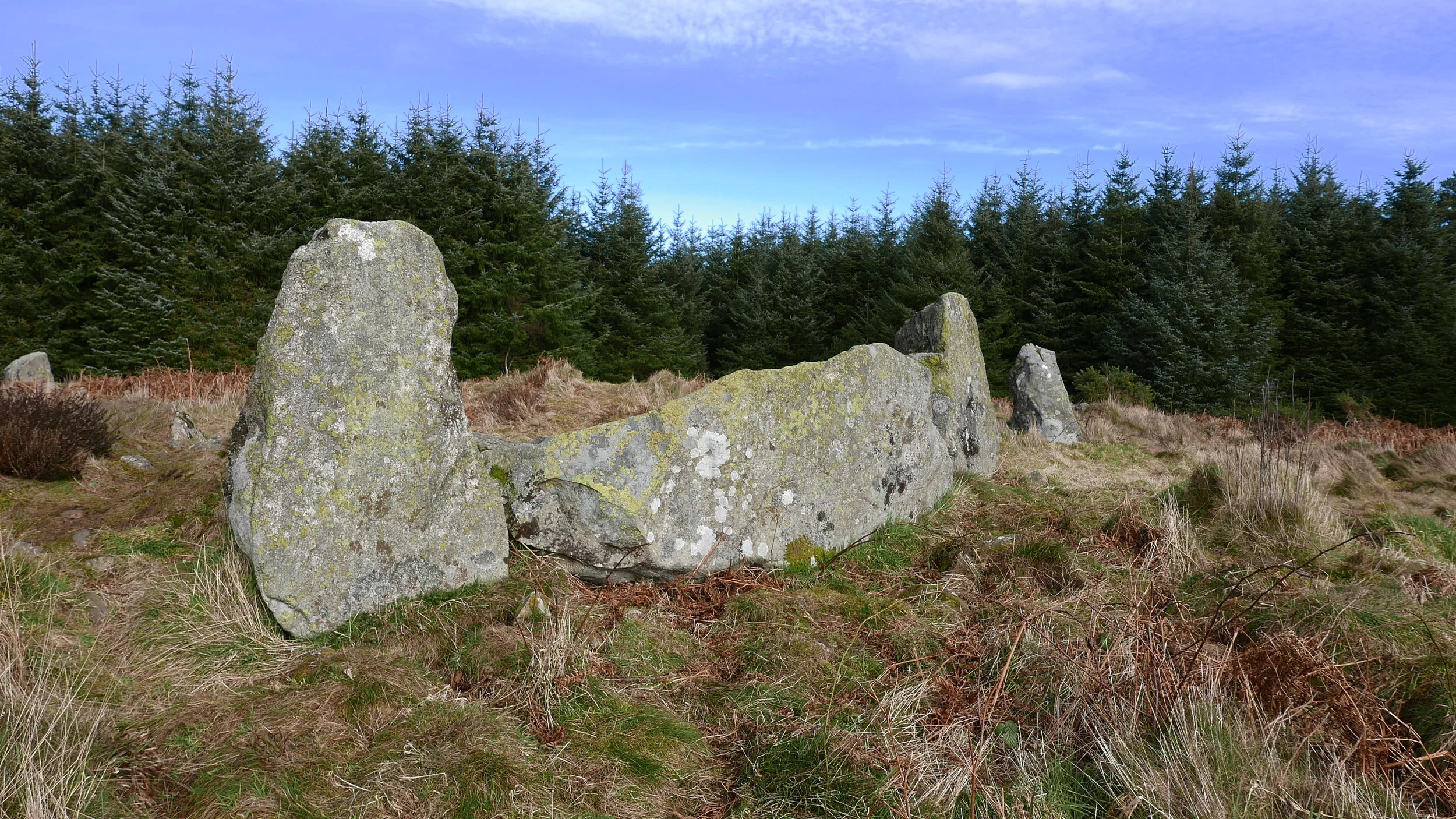Minor broken remains of a stone circle with ring cairn. However, 100 metres higher in the field, in a spot of infinitely greater prestige, there appears to be the significant remains of a Great Temple, perhaps the Holiest of them all. I present you with the following evidence:
These remains are 100 metres further up the field that the standing stone remaining from the RSC marked on OS maps.
Large worked stones in some kind of raised circular setting, not marked on any records as an ancient monument. Also unlikely to have been carried uphill from the the stone circle 50 metres below, as these stones can be seen included in walls and Dykes below, near the farm.
The known circle is at 360 metres, already the highest recumbent stone circle in Aberdeenshire. The position of the ruined remains is indicated with a red cross. This is at 380 metres. Note the two springs between which the Stone Circle sits symmetrically. Also note that Red Hill at 488m and Green Hill at 491m are not only equidistant from this site, but of near identical height. Black Hill at 343m is a prominent feature from the vantage point of the Stone Circle, in alignment with the axis of symmetry between Red and Green Hill.
Recumbent 1 (speculative). A broken, moss covered boulder perhaps, but I think it extemely unlikely that such a perfect specimen for a recumbent were NOT used for ritual magic, particularly as this elevated position has possible the most perfect symmetry and magic about it.
Recumbent 2 (speculative). A gigantic slab of smooth granite measuring 3 m x 3m
Flanker (speculative). I have seen many fallen flankers and this has an unmistakable shape.
Recumbent 3 (speculative). Vast, flat and wedge shaped, this fits the mould of a very significant stone lens.
30th February 2017, 18:00. Notes from Kirk Tough's Grampian Revelations.
"I sit in front of the Holiest Temple of them all, now swallowed up into the earth, silent and eerie. Waters spring from either side of here, and like a serpent's tongue, join and begin their bubbling descent toward the valley. I meditate, open my eyes and see the icy blue Other World, where every pebble, every spec in the infinite cosmos is divine. The vision disappears but I am certain - all matter, all life, all energy, has in its fabric the divine that we cannot see, lest our minds be blown from astonishment. It lies there anyway, and the stone lenses of our ancient ancestors, with their mind-blown dimensions, warp and fold and explode and tear apart the human sight such that in witnessing a single pebble the divine sight may briefly manifest."
And there's a Hobbit hole, underneath what is clearly a standing stone.
So, evidence for a significant stone temple other than the remains of what could be an additional or subsequent centre, is as follows:
1 - Most elevated RSC position in Aberdeenshire (possible the whole of Scotland) commanding a hugely dominant position in the landscape; 2 - evidence of large worked stones above the circle marked as Auld Kirk (stone breakers do not make more work for themselves moving stones uphill; there were many remains lower down near the farm, being used in dykes and walls, such as the "Hobbit hole" above; 3 - auspicious location between two springs with natural symmetry with signficiant topography; 4 - walking around the site, I found two quartz crystals near the spring. Anywhere that yields such crystals so readily, would have been venerated greatly to the ancients. We know they venerated quartz in particular; 5 - is it possible to refute there being a circle here, when there are remains of large stones which surely would have made ideal recumbents?
Maybe I'm getting carried away but all of the above factors lead me to conclude that it would have been the most desirable and prominent location in all of Aberdeenshire for a stone temple, and people as they are, would have determined through conflict, co-operation, influence or bargaining, to use such a site for the highest order of their worship.
Found crystalline quartz.










Extraordinary heavy metal circle near Aberdeen Dyce airport. One of the finest, most complete monuments of its kind. The growing urbanisation surrounding it cannot hold this druidic temple back.